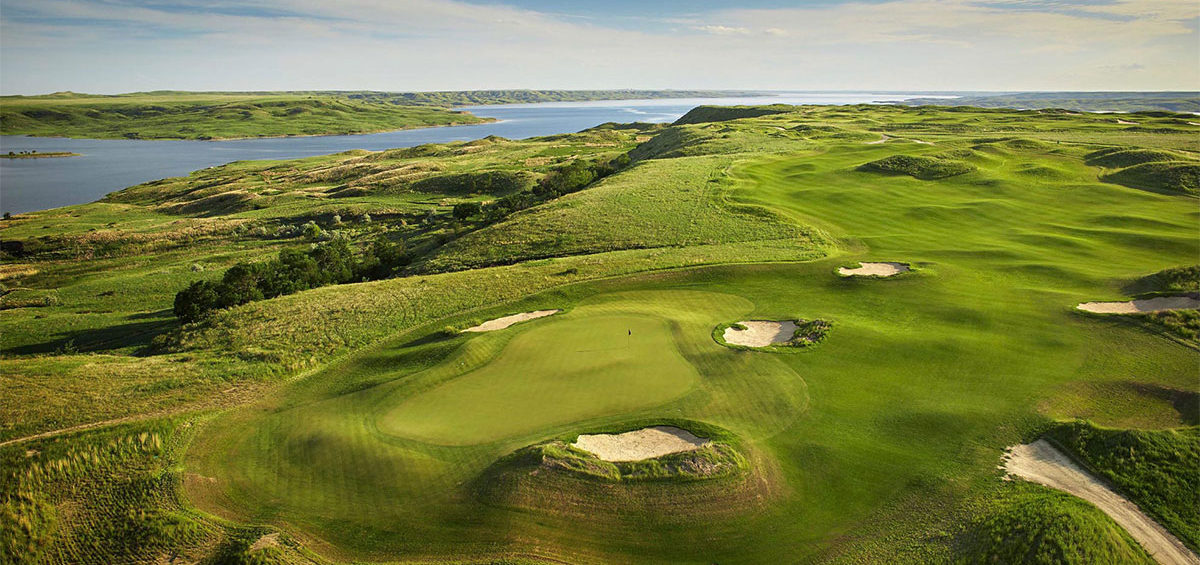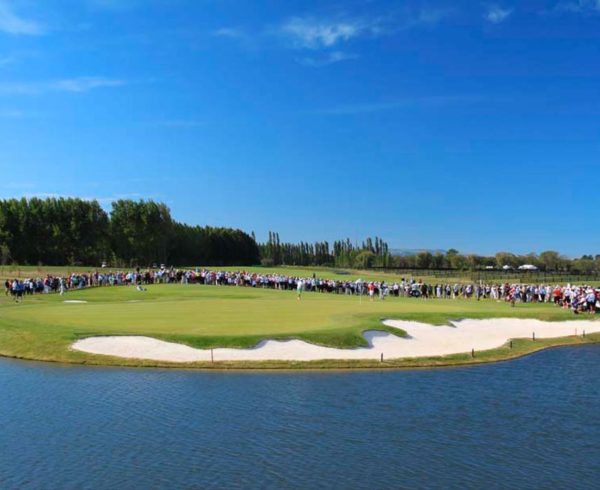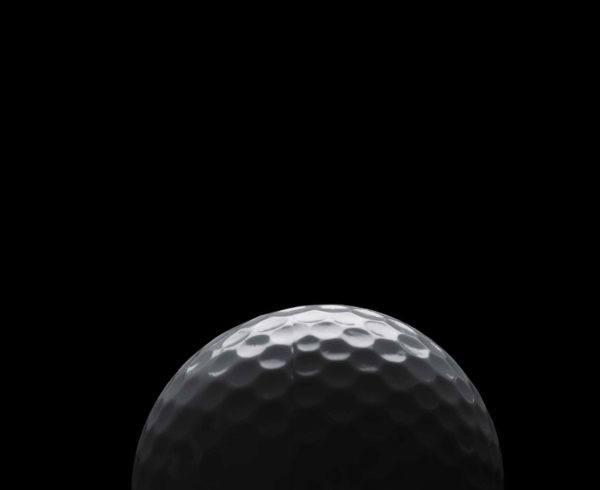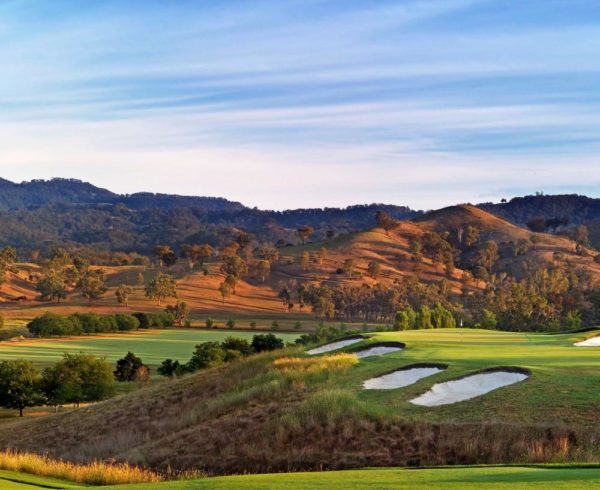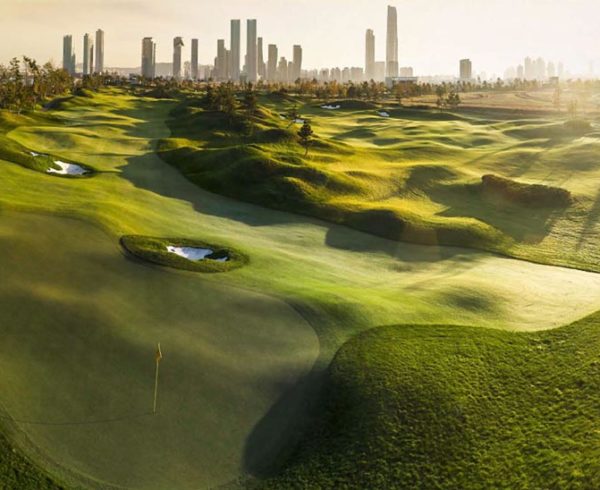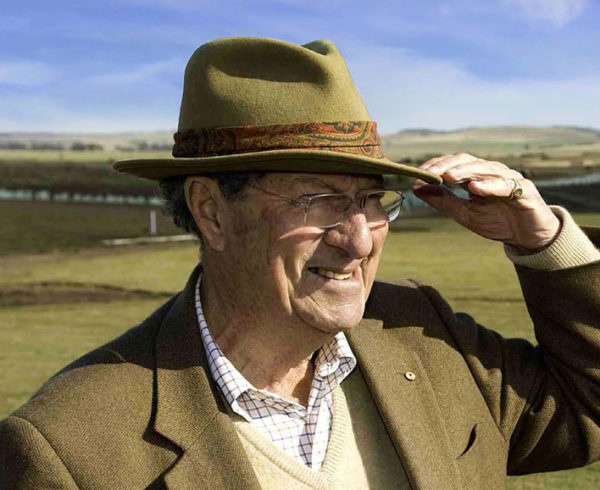Golf in the ‘middle of nowhere’ can be a challenge when it comes to attracting players and also managing the elements. But this stunning, lakeside course in South Dakota has mastered that challenge… and how.
Following the unseemly loss of the initial golf course at remote Sutton Bay adjoining Lake Oahe in South Dakota, along with the high acclaim it had received, the task of designing and delivering another course that could be recognised and equally enjoyed by the membership was indeed a daunting and formidable undertaking. – Graham Marsh


Morning at Sutton Bay looking back over the 10th green to the lodge. The adjoining fairway to the right is the 16th. – Sutton Bay – A Remote Masterpiece in Focus – Issue 17 – Graham Marsh
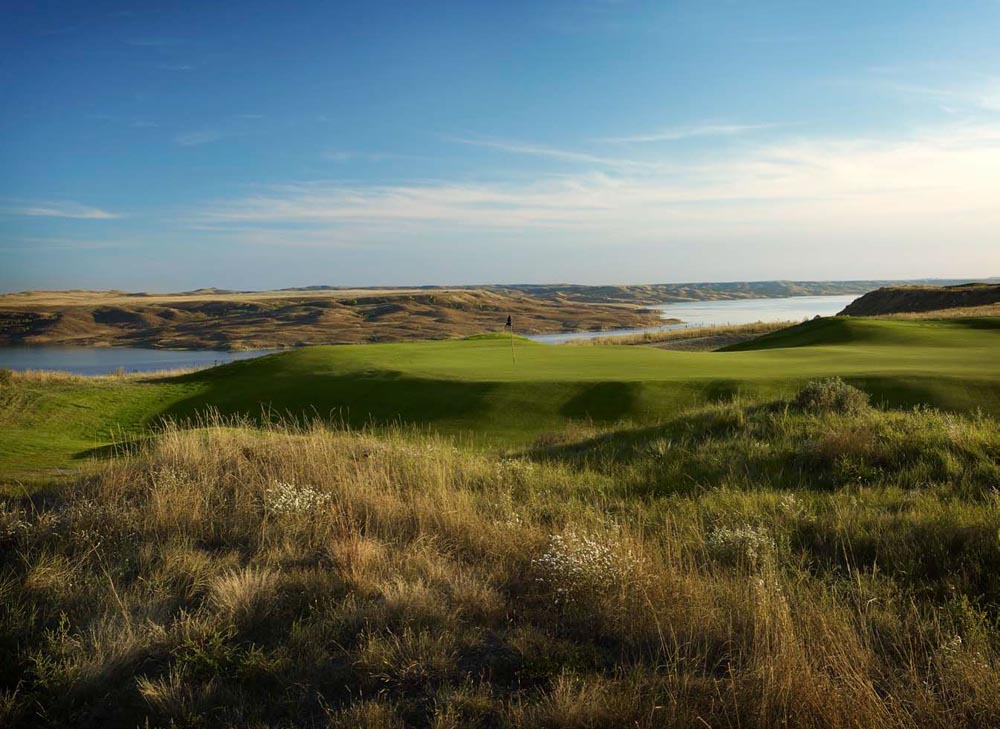

The left section of the 10th green is blind if the golfer pulls (or for left-handers, pushes) their drive left from the tee. Strategy from the tee is critical. – Sutton Bay – A Remote Masterpiece in Focus – Issue 17 – Graham Marsh
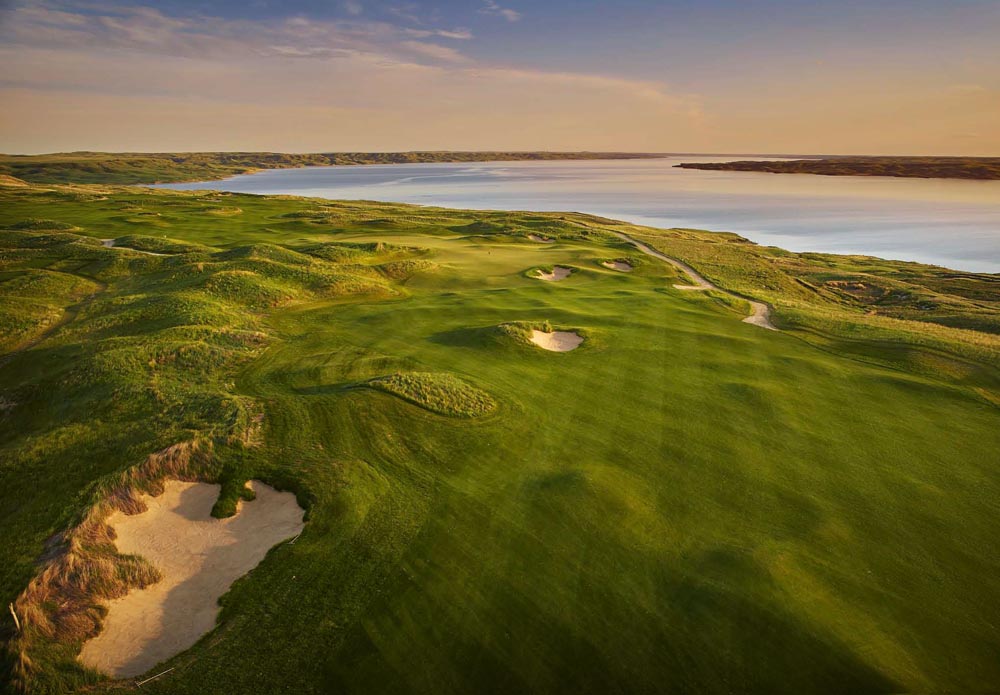

An aerial view of the dramatic par-5 8th –at 600 metres from the ‘Skulls’ tees it is the longest hole on the course. It plays as three strong shots into the wind but is reachable in two when the wind blows from the north. – Sutton Bay – A Remote Masterpiece in Focus – Issue 17 – Graham Marsh
The available land for the new course on the mesa above the classic landforms that existed below was for the greater part almost completely flat, with precious few natural features. Fortunately the one redeeming aspect was that the views from this greater elevation, albeit slightly more distant, were expansive and arguably more majestic in their appeal. With this as the starting point and the knowledge that it was impossible not to have every hole with a lake view, the routing became even more critical to appease those who lamented the loss of a course they had grown to care for and love in a very intimate manner.
The configuration of the best available land dictated that returning nines was clearly the best routing option to maximise views of Lake Oahe and to incorporate areas of the prairie that provided elevation change and strategic double fairway options for a number of the holes.
The ‘out’ nine takes full advantage of the lake views on holes 4 and 5 and on holes 7 through 9. By utilising a crossover at the 3rd and 6th green, it swaps the hazard of the mesa edge from the golfers left to their right. The use of double greens on the 1st and 8th holes and the 3rd and 6th assisted in bringing subtle lake views into holes otherwise restricted by the artificial dunes and the shape of the natural landform that uncharacteristically fell away from the mesa into the rolling prairie. By joining adjacent fairways on many of the holes, views slots were created to provide the golfers with long-range glimpses of Lake Oahe. It also acted as mechanism of disrupting the monotony of simply playing between rows of dunes.
The ‘in’ nine offers a complete diversity of movement as it loops back and forth traversing the prairie on holes 12 through 15 and at the same time taking advantage of the lake views on the five other holes. It is more of a ‘Muirfield’ type loop that challenges the golfer by the use of directional changes. This, combined with moderate elevation changes on a number of holes ensures that a player must be on point at all times to accurately determine club selection.
Unlike the previous course that was discovered amongst the classic landforms, the new course was created using all of the modern day design technology and construction equipment available. To create a genuine inland links golf course 270,000 cubic metres of earth was moved across the site. An area equal to that of the grassed playing surfaces was disturbed and needed to be revegetated in prairie grasses.
For the most part the soils were heavy farming clays and precious little top soil was available, especially along the ridges of the mesa. The cuts and fill necessary to create the design and drain the site in a number of instances were quite substantial and after grading to design levels the base soil proved to be virtually inert. Given the fast track necessary for the completion of the project it was decided that trying to strip the limited amount of top soil was a fruitless exercise and that a better solution was the ongoing development of a quality root zone via an aggressive coring and topdressing regime.
From a design perspective I did not want the course to impose on the landscape. Perhaps my goal in this endeavour can be best reflected by the words of John Christiansen, the shaper from Omaha who followed our plans so fastidiously during the development of course.
One morning he observed that “… the shapes appeared as if the course below had been transported up on top and that it was simply a mini version or reflection of landforms below”.
This was like music to my ears, as whilst the creation of an inland links course was foremost in my mind, I did not want the artificial dunes to appear out of context and so irregular that they would look foreign in this environment.
The climatic zone for the Sutton Ranch property has been described as a ‘high desert’. On average it receives only 16 inches of rainfall annually, the majority being deposited in May and June. The variables of the climate on a day-to-day basis is a superintendent’s worst nightmare. Not paying attention to detail on an hourly basis can trigger a chain reaction leading to a highly undesirable outcome.
Choosing grasses that were sustainable over time and offered the experience of a true inland links experience was a critical component of achieving the complete design philosophy. The low-mow Kentucky Blue grass had been proven since 2003 when the first course was opened and for the heavier soils it was a huge success.
The greens are a 50-50 mix of Alpha and T-1 bent grass and the tightness and firmness ensures that these surfaces play like a true links golf course. The real advantage of this mix for the greens and the low-mow KBG for the fairways is their ability to withstand the severe climatic conditions of South Dakota.
The choice of grass for the collars was more problematic as I wanted them playing like the greens to bring the ground game into play. For me this was a critical aspect for the playability of the golf course given the wind in South Dakota. The collars had to be firm and allow balls to be run onto the putting surfaces, not just from around the edges but also from a distance. If this is not the case, front pins become a totally unfair challenge and take away the true essence and meaning of the ground game.
This was like music to my ears, as whilst the creation of an inland links course was foremost in my mind, I did not want the artificial dunes to appear out of context.
Fescue collars proved to be too much of a challenge in the heavier soils, as did bent grass.
The combination of a mix of fescue and the low-mow Kentucky blue grass did however prove to be an absolute winner. Approximately a 40% fescue, 60% KBG mix is working extremely well and putting or running the ball in some form from 20-30 yards off the actual putting surface is now an accepted practice by much of the membership. The combination of the grasses also allows for a limited watering regime, thus keeping the surrounds firm and fast at all times and allowing for challenging front pins to be used on a rotational basis regardless of the prevailing wind on any given day.
One of the subtle charms of links golf is that by changing a pin location on a green by only a few metres it can dramatically change the strategy of the hole. The line of approach is so often predicated by the angle and shape of a mound either in the green or the surrounds of the green. Wide fairways so often lure the golfer into a false sense of security. Paying attention to the greater picture including the green contours and surrounds, before the tee shot is struck is one of the prerequisites of successfully mastering the art of scoring on links courses. This is just one of the key reasons why links golf has prevailed and will forever stand the test of time.
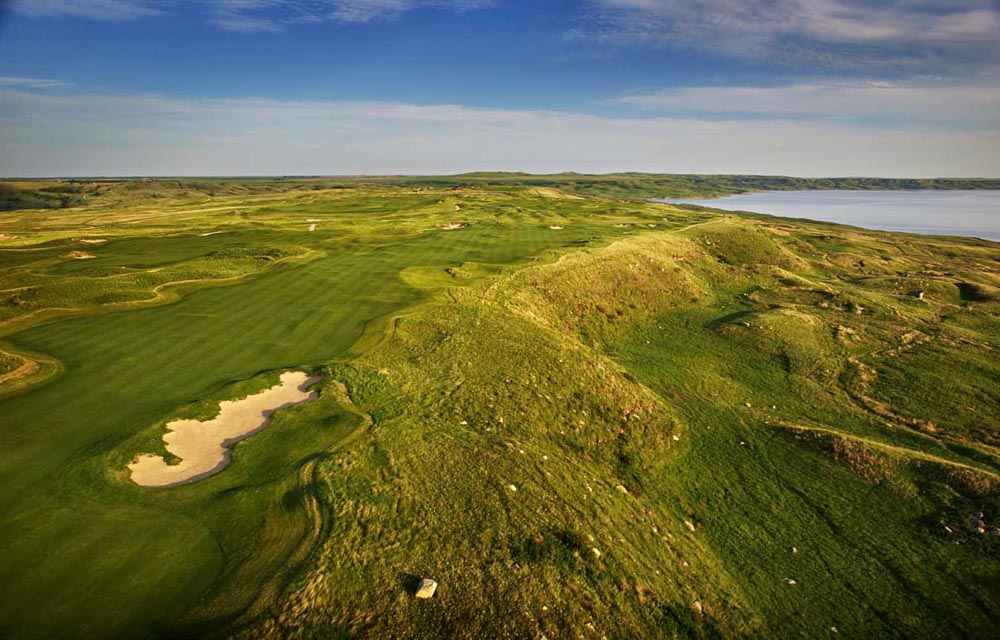

An aerial view of the par-5 8th and the mesa it abuts on the right. This dramatic dogleg to the right offers challenges from start to finish. – Sutton Bay – A Remote Masterpiece in Focus – Issue 17 – Graham Marsh
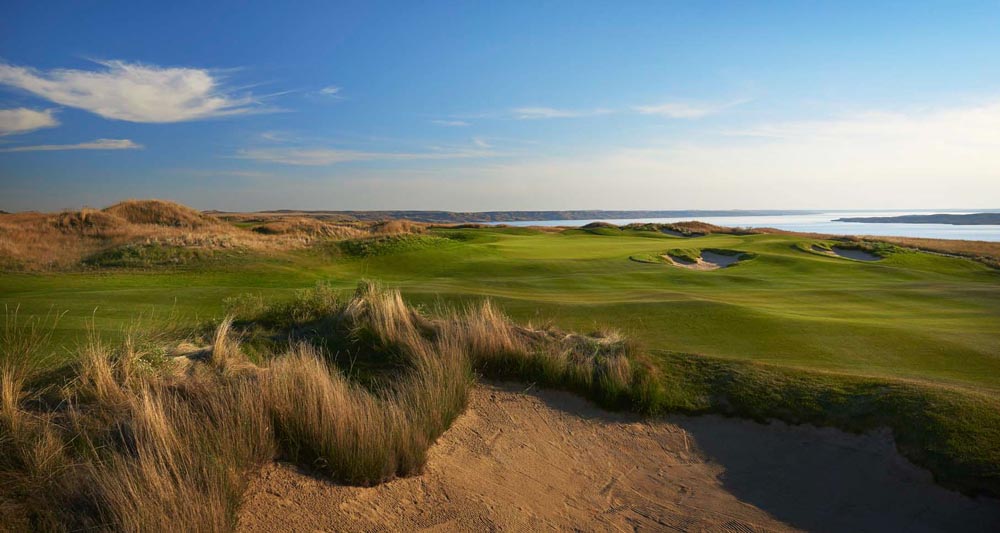

The native prairie grass forms a backdrop to most bunkers and all greens have an entrance to the putting surface so the ground game can be exploited. – Sutton Bay – A Remote Masterpiece in Focus – Issue 17 – Graham Marsh
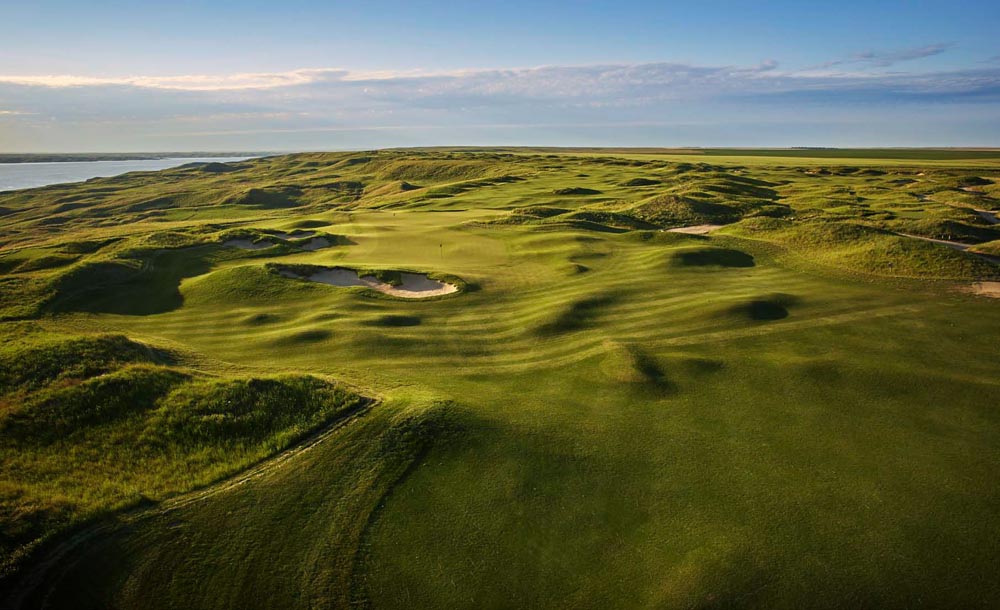

Sutton Bay – A Remote ABOVE: A simple yet thoughtful opening hole. Left pin positions are guarded by the lone bunker on the left and right pins are subtly framed by the mounding on the right side which slopes towards the lake. – Masterpiece in Focus – Issue 17 – Graham Marsh
Another aspect of links golf is the unevenness of many lies that are encountered during a round. Shaping shots from uphill, downhill, side hill and hanging lies under varying weather conditions stimulates players to learn and adjust their games. It gives golfers a great appreciation and understanding that golf is considerably more than learning to hit the ball on a driving range. This challenge of irregular lies applies to all and offers much less frustration than deep bunkers and penal long grass lining narrow fairways. Once a semblance of skill is mastered with uneven lies the game takes on a new dimension only adding to the thrill and excitement of a well struck shot.
The expansiveness of the undulating fairways is a blessing for the average to high handicapper. At the same time it seduces the longer hitter into a power and not a positional game. Rarely does target golf not favour the more accomplished by a disproportionate amount.
Conversely the ground game allows the less talented to move towards the target with less strain and achieve results that can at least fulfil their goal of personal achievement and enjoyment. It is already noticeable that the average players at Sutton Bay are enjoying themselves and scoring better whilst the lower handicap players are finding it more difficult to post a lower score and play to their handicap consistently. Mission accomplished.
The diabolical winds that from time to time sweep across the prairie, played a huge role in the overall framing of the design parameters of the golf course. Apart from the necessity of fairway width and openness to the putting greens the location of bunkers both from a strategic functional and visual value was critical. The rustic bunkers on the previous golf course were extremely well received and fulfilled all of our guidelines so it became logical that we would retain the same look.
This style has proven to be low maintenance, easy-for-player access and capable of withstanding the severe elements. Once the edges are fully established with the desired native grasses they will serve the club well into the future.
It is so important for the membership at a remote Club like Sutton Bay that they can plan a trip and still be assured of playing golf even when the weather is inclement. Historically, weather is part of the game itself; however if the course is overly taxing then all enjoyment for the game is lost. The challenge of playing a fair course in adverse weather conditions can be an exhilarating experience and one to be relished rather than rejected. It will be a sad day for this great game if we only wrestle with the course in perfect conditions.
The areas of disturbance on site necessary to achieve the bulk earthworks to create the design were approximately the same as the tees, fairways and greens. The artificial dunes and other works area was secured by laying sod around the perimeter adjacent to the fairways tees and greens and then seeding this entire area by hydro-mulching. It is only now some three years after this seeding process that the native mix is starting to frame the golf course. I am anticipating that it will take at least another full growing season, or perhaps two, before we have complete coverage to our liking in these areas.
It has been said by so many that out of moments of great disappointment there always seems to be another way forward that can ease the pain and shed new light. Only golf architects who›ve been entrusted by others to deliver their dreams will fully understand the dedication it takes to deliver.
It is a painstaking devotion and commitment that consumes not only our time but our imagination and physical effort to extract every last ounce from a site in an endeavour to excite challenge and entertain the golfers who play our courses. We indulge ourselves in countless ways to excel and produce what we hope are masterpieces that are capable of growing the game and our industry.
I feel privileged and honoured to be given this chance at Sutton Bay. A remote and faraway place where 30 year ago it would have been conceived as madness to design and build a golf course others would travel to play.
The game knows no limits – onward towards the next 50 years.


